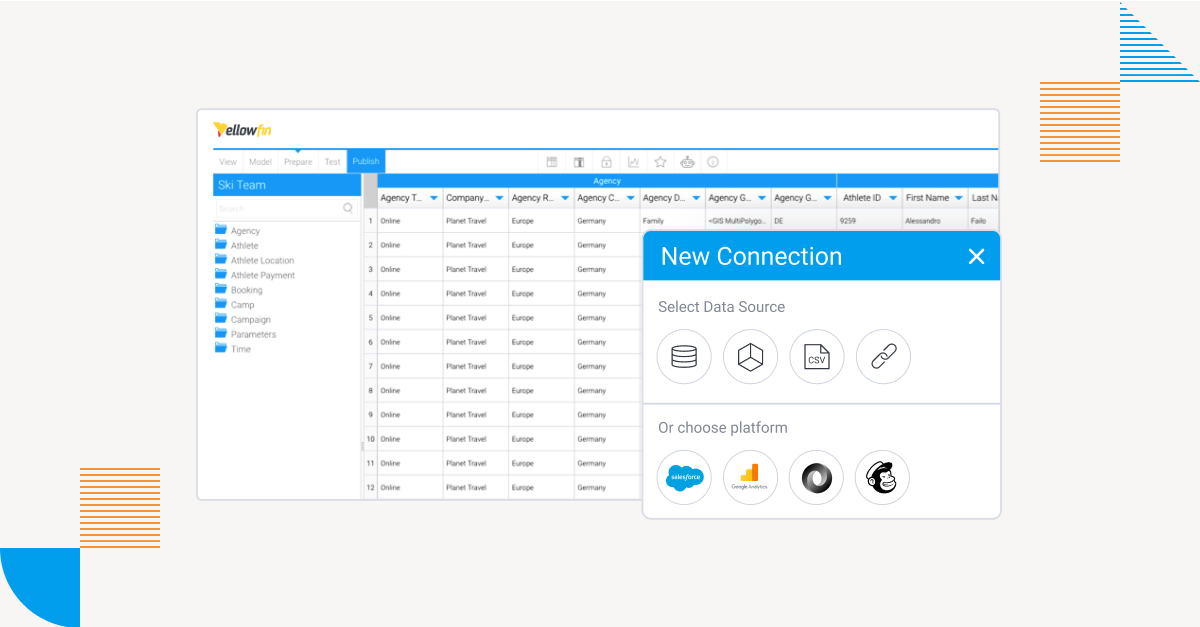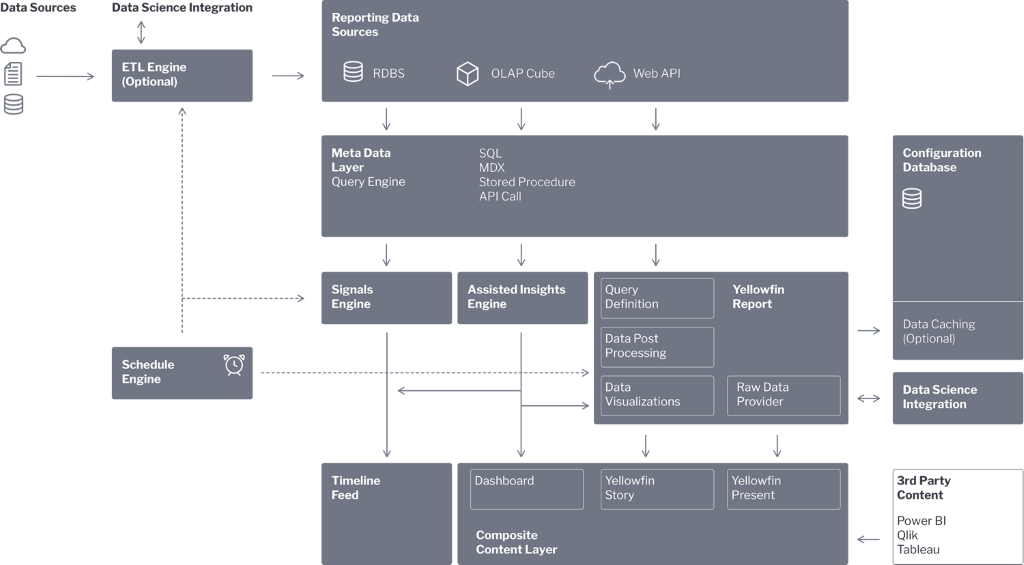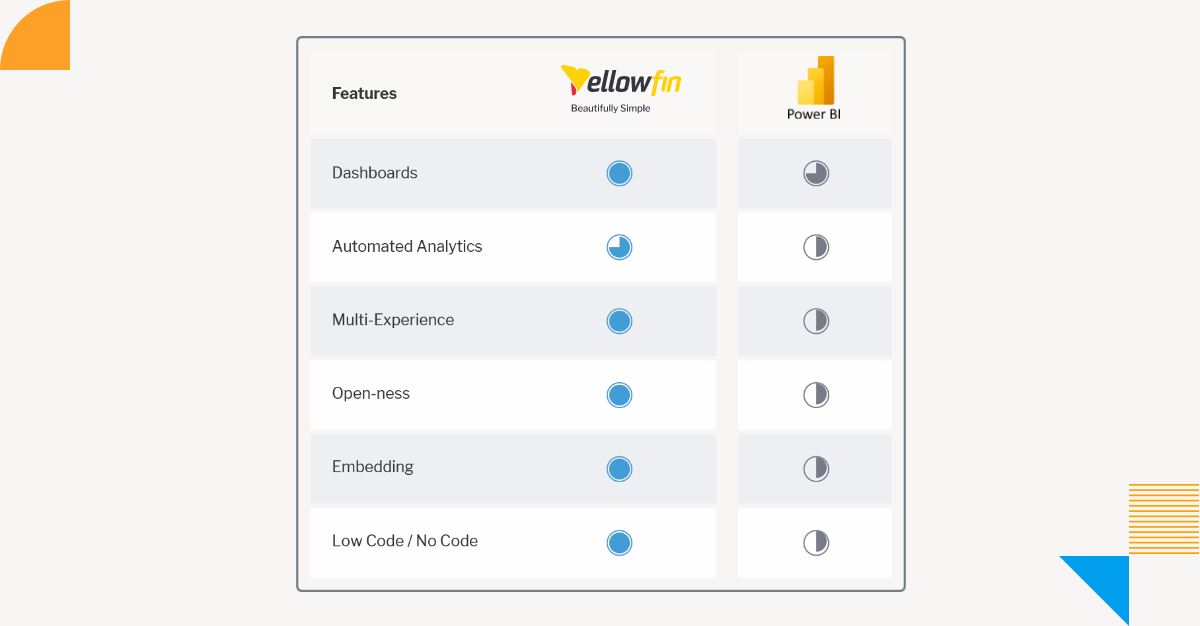
How to Evolve Your Power BI Solution With Yellowfin
Microsoft Power BI is a ubiquitous business intelligence (BI) solution entry point that can create a good foundation for analytics capabilities at any company. Similar to Tableau, the objective is to create broad adoption within an organization and replace Excel with a more powerful and structured tool.
One of the key challenges it presents, however, is complexity for the data team, as Power BI’s approach is decentralized with multiple individuals and teams building solutions that can be interrelated, and new users often get lost just as quickly as they get started.
Yellowfin is a great complementary solution to choose when you want to build a more accessible and sophisticated embedded analytics solution built to support enterprise use cases tailored toward operational reporting and analytics, has robust data governance, data security and analysis features, and which services a broader range of users.
Yellowfin vs Power BI: Which Analytics Tool is Best?
The neat thing about both Yellowfin and Power BI is they can easily co-exist in an organization, and you can leverage their individual strengths.
At their core, Power BI is ideal for individual users and small departments, while Yellowfin is best suited as the backbone of your organization-wide operational reporting and analytics. Yellowfin is especially differentiated for embedded BI use cases, where you want to style and integrate analytics directly into your internal or external applications.
Unlike Power BI, Yellowfin relies on meta-data models that provide a more structured approach toward data and data governance. Yellowfin can also report from operational data sources and does not require proprietary data cubes, which makes it optimal for live data reporting.
In this blog, we will cover some of the key differentiators between Power BI vs Yellowfin, to help provide you with a better understanding of which analytics suite can suit your use case needs.

1) Governance and Security
Data security (the practices, processes and tools that help protect your sensitive data) and data governance (the lifecycle management practices and accountability measures that help keep your data reliable) are two important considerations for any company buying a BI solution.
Yellowfin places both data governance and security at the forefront, with several capabilities that help enforce protection and accountability over data sources.
- Data security management: Yellowfin centralizes the tracking of data usage, management of deployment and optimization of the BI environment by enabling admins to view, manage and search system-wide configurations consisting of data sources, users (groups and roles) and metadata layers, all from one place via its Administration Console.
- Role-based access control (RBAC): Role-based access controls allows you to manage the available system functions within the application (report creation, data story authoring, etc) for individual users and their assigned role, in addition to links and permissions over what data is made available for reporting. RBAC is important to define control over what information is accessible and shareable among users based on their specific departments or needs, and Yellowfin offers highly flexible and easy-to-configure RBAC.
- Secure meta-data layer: Yellowfin provides a highly secure meta-data layer that sits between the user interface and the queries sent to the data-base. Meta-data is what describes each data object in a database, providing necessary context on the metrics within columns and rows (upload date, data formatting, type of data, etc). The meta-data layer is core to Yellowfin’s data security offering, with features such as Access Filters (configurable restrictions at the row-level on availability of data based on the user running a report), Column Level Security (ability to secure columns individually to protect sensitive information from being queried via self-service BI reporting only by those with proper role) and Data Source Substitution (multi-tenancy feature which enables the ability to switch what data source a report is running against based on the organization a user is part of when the report is run).
You can read more about Yellowfin’s security model, security & compliance accreditation, and functional user access and content protection controls at the provided links.

In comparison, Power BI is built on Azure, Microsoft's cloud computing infrastructure and platform, and its two-cluster architecture handles all connections, authentication and user interactions with the Power BI service. Power BI uses integrations with another Microsoft product, Azure Active Directory (Azure AD) to store and manage user authentication and user identities. Power BI users also have other data security concerns such as data storage and metadata handled via integrations with two further tools (Azure BLOB and Azure SQL Database).
In short, much of Power BI’s data security and governance is spread out across the Microsoft software-as-a-service ecosystem. Having much of its security functions spread across multiple programs can lead to complexity if your business is not all-into Microsoft’s software stack.
Some areas where Power BI falls short in comparison to Yellowfin include:
- Setup users from multiple domains
- Sophisticated governance and multi-tenancy
- Centralized reports with data sources in a multi-tenancy environment
- Approval processes for report creation
Overall, Yellowfin BI has stronger governance and security capabilities as it is designed to handle enterprise use cases with centralized data governance and complex user access parameters.
2) Hosting
Yellowfin is a 100% web-based BI suite in the cloud, designed to enable customers, from a number of different industries and sectors, with an effective way to modernize their existing homegrown or legacy reporting solutions that may no longer fulfill their users’ analytics requirements.
Yellowfin is built around the foundations of openness and extensibility, and its approach is specifically designed around offering businesses many ways to deploy their Yellowfin embedded analytics software based on their own unique infrastructure and configuration choices.
- Environment-agnostic flexibility: Whether it’s SaaS, MSP, or on-premises hosting, Yellowfin allows businesses to deploy their Yellowfin analytics instances in any environment they wish. Yellowfin will work with all major cloud providers (AWS, Azure, Google Cloud Platform, etc) as well as it will work on-premises in existing data centers.
- Extensive extensibility: Yellowfin provides businesses with several ways to extend its functionality, via creation of custom workflows, unique user experiences, code extensions, no code/low-code scripting, and more, which you can read about here.
- No vendor lock-in: Yellowfin grants you access to the source code of the platform in the event of insolvency on the part of Yellowfin, and access to your content design and code extensions, which you fully own and can use towards reengineering efforts. Your data can be stored inside any database of your choice, and is owned and accessible to you at all times. There is also no proprietary database or proprietary scripting language to move, store or access data.

Above is a visualized diagram of the key components of Yellowfin’s architecture and hosting structure. For more information, please visit this page on Yellowfin technical architecture.
Power BI is designed to drive the adoption of Microsoft Azure cloud first and foremost and by default has more limited hosting options. Because of this, Power BI is not suited to support easily build proprietary embedded SaaS offerings, leading to potential implementation and technical complexities. Key limitations of Power BI in the hosting area include:
- Limited on-premises options - many doubt that MS will support this long-term
- Difficult to package your own SaaS solutions
- Optimized to run on Azure - it can leverage other clouds for data
- Some security needs to be handled through infrastructure
Overall, Yellowfin provides more flexible and extensible hosting options for businesses valuing no vendor lock-in and environment-agnostic hosting options above all else. Meanwhile, Power BI may suit your business needs in certain areas if your organization is already invested heavily into Microsoft’s SaaS ecosystem and Azure Cloud infrastructure.
Download Whitepaper: Why Open Archtectures Matter in Business Intelligence
3) Functionality
Functionality is a very broad category with ambitious roadmaps for all vendors. Many customers argue that there may be in fact too many many features in analytics platforms that are frequently not that relevant or utilized across the suite, and major advances in technologies such as Natural Language Query (NLQ) and artificial intelligence (AI) are likely going to be slow to gain day-to-day applications, despite the hype.
Below, we focus on the core features that are fundamental for most BI deployments, but which present challenges for many organizations today:
- Limitations on scheduling and refresh for import datasets (8x/48x/day) with premium cost model
- Direct data access (Direct query) also has limitations that will improve with ‘Fabric’, but will face similar cost implications
- Old-school reporting (paginated) not fully integrated
- DAX (collections of functions, operations, and constraints) is getting more complex, not dissimilar to Excel ++
- Handling of huge amounts of data getting complex and expensive due to fundamentally different approach in data handling (SQL generation vs. Import)
- Data storytelling out of the box being complicated to implement
The use cases where Yellowfin BI’s functionality is optimized focus on:
- Full integration into the application and white labeled
- Support advanced data analysts or casual business users (Guided NLQ) for centralized operational analytics
- Self-service BI with a focus on operational analytics vs data science use cases

A summary comparison of Yellowfin vs Power BI in terms of features and services.
4) Business Model
Power BI and Yellowfin differ significantly in business models. Yellowfin originates in the embedded BI and white labeling use cases that require significant flexibility and allow for revenue share, value-based pricing, etc. Power BI evolved and owes its success to the proven Microsoft freemium model. It is meant to be ubiquitous, similar to Excel, but also drives Azure use and covers more enterprise use cases to generate meaningful revenue. Here are some key considerations for businesses comparing Power BI with Yellowfin:
- Power BI is fairly cheap or free to start - in a typical MS model, you get it as part of their bundle of offerings, but generally Pro can start as little as $10 per user per month. However, premium and enterprise features add up, so you should take time to develop an “apples-to-apples comparison.”
- Power BI is ultimately designed to drive Azure usage - with the new ‘Fabric’ model you will likely have even fewer capabilities outside of Azure.
- Limited revenue share and value-based models - even large companies are probably too small for Microsoft to care about developing anything custom, which is not a problem for standard use cases, but anything embedded and/or more integrated to your go-to-market (GTM) strategy will be difficult to address with Power BI.
In comparison, Yellowfin has multiple pricing models to fit the individual use cases of our customers. Many built significant parts of their products with Yellowfin BI and pricing models are very tailored to align with your own unique customer KPIs.
Read More: Yellowfin Pricing
Yellowfin or Power BI - Which is Better?
Both Power BI and Yellowfin BI have robust functionality that will meet analytics requirements for customers. PowerBI is easy to adopt and use in many parts of an organization. However, there is a reason that Excel, despite its power is not used for enterprise analytics, or companies did not build applications with it.
Centralized or Embedded / White-Labeled use cases require both specific functionality and a business model that are different from generic BI solutions. Yellowfin was built to address such use cases.
Modern organizations will likely have 2-3 BI tools (many have quite a bit more, but that is not necessary). At the end of the day, Yellowfin BI and Power BI can live well together and excel in their own areas of expertise.
Next Steps for Power BI Users: Explore Yellowfin
Enhance and evolve your existing Power BI implementation, and/or see how Yellowfin stacks up to Microsoft's solution with our free demo experience.